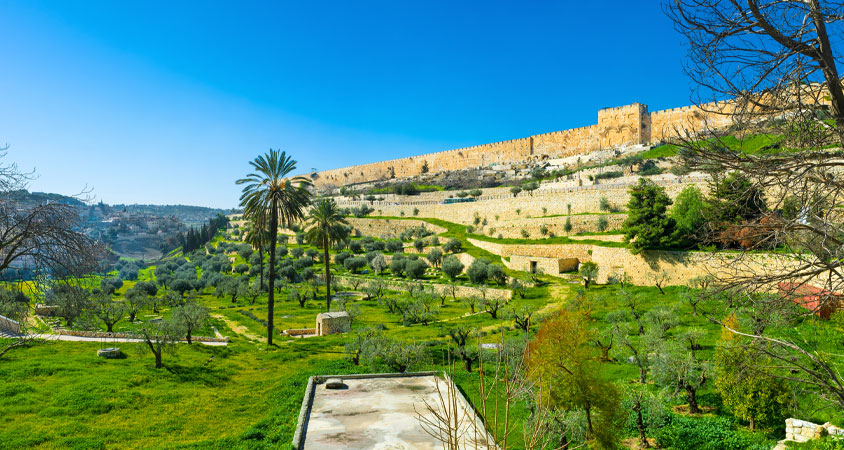Known in Scripture only as “the brook Kidron,” the Kidron Valley runs north to south between the Mount of Olives and the eastern wall of the Temple Mount. The 20-mile long stretch naturally descends 4,000 feet and tapers off into the Dead Sea. Originally filled by the Gihon Spring, the flow of water in the valley was eventually diverted through the construction of complex water supply systems during the Canaanite and Israelite periods.
The Kidron Valley was traversed by many notable biblical figures, including David, who was described crossing the brook barefoot and weeping while fleeing from Absalom (2 Samuel 15); and even Jesus Himself crossed the valley to meet with the disciples (John 18:1-2). It is also the place believed to be where Jesus was tempted by Satan to jump (Matthew 4:8) during His testing in the wilderness. The valley is also home to the Garden of Gethsemane, where Jesus prayed the night before His Crucifixion.
The northern valley, also known as the biblical King’s Valley, mentioned in Genesis 14, sees the most foot traffic, given its proximity to strategic sites in Jerusalem. Visitors are free to walk the white stone path into the heart of the valley to view the scores of olive trees and 2,000-year-old monuments which face the Temple Mount.
The monuments, named after biblical figures, are tombs of prominent residents who dwelt in Jerusalem during the Second Temple Period:
Absalom’s Tomb
Perhaps the most notable of the tombs is Absalom’s Tomb, or Absalom’s Pillar, named for the reference found in 2 Samuel 18:18. Popular Jewish tradition maintains this is the actual pillar of Absalom, son of David, but it is more likely the tomb of a wealthy Jerusalemite.
The Cave of Jehoshaphat
Not far from Absalom’s Tomb is another set of tombs, known as the Cave of Jehoshaphat. While belonging to a prosperous family residing in Jerusalem during the Second Temple Period, tradition suggests that the tomb is the burial place of Jehoshaphat, King of Judah, even though scripture specifies his final resting place was the City of David.
The Tomb of Zechariah
The name suggests, as many others do, that a biblical figure is buried here…yet there is no grave inside. Instead, visitors to the Tomb of Zechariah are actually viewing a cenotaph—a tomb or monument which commemorates an individual who is buried elsewhere. Adorned with Ionic-style pillars and an Egyptian pyramid as the cornice, the tomb is a popular stopping point for those passing through the valley.
In 1989, archaeologists uncovered a complex of large rock-hewn tombs at the juncture of the Kidron and Hinnom Valleys, near the village of Silwan. Further excavation of the tombs revealed a wealth of artifacts, including potsherds, glass vessels, and oil lamps, used up until the end of the Second Temple Period. The tombs, collectively known as the Akeldama (Field of Blood) Tombs, are part of an extensive burial ground believed to have been purchased by Jewish leaders with the 30 pieces of silver Judas received for betraying Jesus and returned when He was condemned to death. It is also believed to be the place where Judas subsequently hanged himself.
Traveling the Kidron Valley is a great way to experience Jerusalem from a unique vantage point, and definitely a trek to make in the afternoon on a sunny day. From the Old City, it’s about a 15-minute walk to the Garden of Gethsemane. For a more panoramic view, you can see the valley from the Old City wall or atop the Mount of Olives.
Why not start planning your Israel experience right now?
Visit www.israeladvantagetours.com to make your trip of a lifetime a reality!















